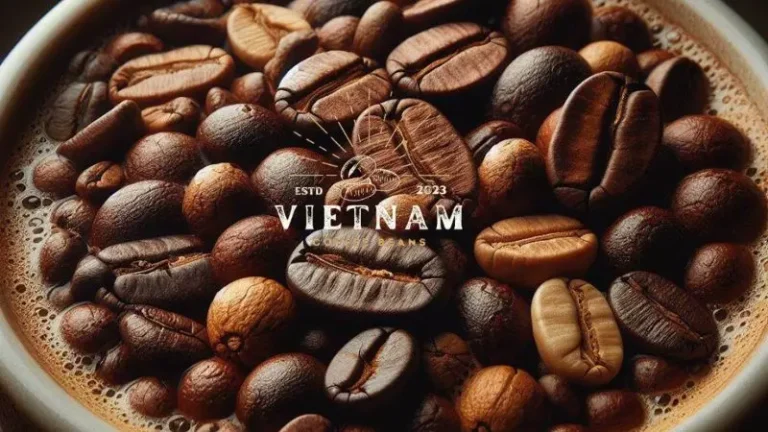Bourbon coffee refers to a variety of Arabica coffee that originated on the island of Réunion in the Indian Ocean. It is descended from the original Yemeni coffee introduced to the island in the 1700s.
This specialty coffee is known for its tall growing trees yet relatively low production output. However, what Bourbon lacks in yield it makes up for in exceptional flavor. It brews a coffee with tasting notes of fruit and freshness.
Bourbon eventually spread from Réunion to other regions like Central and South America. Its origins from the Indian Ocean island contributed to Bourbon’s unique attributes and excellent drinking quality.
In this article, we’ll explore the history of this coffee, its growth traits and yield potential, rich taste profile, and more. Discover what makes Bourbon such a treasured and influential Arabica variety.
Key Takeaways
- Bourbon is a variety of Coffea arabica that originated from Yemen and was brought to Bourbon Island (now La Réunion) by French missionaries in the early 1700s.
- Bourbon was introduced to Brazil in the mid-1800s and rapidly spread to other parts of South and Central America, where it became mixed with other Bourbon-related diversity from India and Ethiopia.
- Bourbon is characterized by low production, susceptibility to major diseases, and excellent drink. It grows best at heights between 1,100 and 2,000 meters and gives a 20-30% higher yield than Typica, but is generally susceptible to disease and pests.
- Although Bourbon itself has largely been replaced by diversity that descend from it (such as Caturra, Catuai, and Mundo Novo), it is still cultivated in El Salvador, Guatemala, Honduras, and Peru.
What is Bourbon Coffee Called?
Bourbon coffee beans are a sub-species within the Coffea Arabica species. More specifically, Bourbon is one of three primary varieties of Arabica coffee along with Typica and Heirloom.
First developed on the island of Bourbon, now known as Réunion, Bourbon coffee traces its lineage back to the original Arabica coffee plants. It was eventually brought to the Americas in the 19th century.
As a high quality Arabica variety, Bourbon coffee beans are prized for their excellent cup quality and flavor. The Bourbon varietal, along with Typica and Heirloom, form the foundational Arabica types that contribute to many of today’s coffee cultivars.
So in summary, Bourbon coffee is an esteemed Arabica sub-variety appreciated for its role in coffee history and genetics. Its relationship to other major Arabica types gives Bourbon distinctive value.

Origin and History Of Bourbon Coffee
Bourbon is the most famous coffee variety descended from Yemen. French missionaries introduced these Arabica trees from Yemen to La Réunion island, known then as Bourbon Island, in the early 1700s.
Bourbon remained isolated on the island until the mid-1800s when it spread to Africa and the Americas. Around 1860, the variety made its way to Brazil and quickly fanned out across South and Central America.
In these regions, Bourbon mixed with other varieties like those from India and Ethiopia. Today, Bourbon-descended varieties like Caturra, Catuai, and Mundo Novo predominate in Latin America. But Bourbon itself is still grown in some countries like Guatemala and Honduras.
So while Bourbon originated in La Réunion, its journey to the Americas allowed it to become an influential ancestor. Its excellent cup quality and genetics contributed to new coffee cultivars that retain Bourbon’s prized attributes.
Bourbon Genetic and Characteristics
Bourbon coffee offers a unique cup with its genetic origins tracing back to Yemen. This tall Arabica varietal is known for its chocolatey notes and maple syrup-like taste profile.
The beans also have a deep, complex flavor with nutty and sweet hints. Bourbon’s aroma often carries caramel and vanilla tones as well. These distinctive characteristics come from Bourbon’s lineage.
In addition to its prized flavor, Bourbon can produce relatively high yields despite low production volume per tree. It also has natural resistance to many major coffee diseases.
With its exceptional taste, aroma, and resilient yield, Bourbon is a popular choice for specialty coffee producers. Its genetics contribute to a one-of-a-kind coffee experience. As we explore further, you’ll learn what growing conditions allow Bourbon’s qualities to thrive
Growing Conditions

It’s no wonder why this classic coffee has become so popular – it’s ideal conditions make it a sure-fire hit for connoisseurs! This is best at heights between 1,100 and 2,000 meters, producing a higher yield than Typica with a similar.
In addition, Bourbon typically yields 20-30% more than Typica and has a commercially viable level of yield potential and growth habit. Bourbon is also often used to taste organic and cocoa-flavored coffee beans, as well as whole coffee beans, giving them a delicious, unique taste.
The tree can rise tall and has a medium yield potential of very good cherries, although it is susceptible to the major diseases. With all these benefits, it’s clear why this is a favorite among lovers. Moving on from its conditions, it’s easy to see why the yield and quality is so highly praised.
Yield and Quality
Experience the incredible yield and quality of this classic diversity, which is 20-30% higher than Typica and produces a commercially viable level of yield potential and growth habit.
From the Manhattan-style Barrel Aged to the classic Kentucky Bourbon Whiskey, the Pecan Bourbon to the Coffee Bruvet, it offers an impressive range of taste due to its unique blend of taste and characteristics.
Not only is it full of taste, it also has a high yield potential, making it an excellent choice for cultivation and distribution. Plus, its susceptibility to major diseases makes it an ideal diversity for different climates and conditions.
With its combination of yield and quality, it’s no wonder this is a favorite among connoisseurs all over the world. Transitioning into the next section, Bourbon’s wide distribution and cultivation are what make it a beloved diversity today.
Distribution and Cultivation
You’ll love the wide distribution and cultivation of this classic diversity, making it beloved all over the world. This is a cultivar of Coffea arabica that is known for its quality cup and low production.
It is one of the two main varietals from which many new cultivars are bred, the other being Typica. French missionaries originally introduced Bourbon from Yemen to Bourbon Island in the early 1700s and it was not until the mid-19th century that it began to spread to other parts of the world.
Bourbon now best at heights between 1,100 and 2,000 meters and can be found in many countries, including Brazil, Ethiopia, El Salvador, Guatemala, Honduras, India, Peru, and many more.
Bourbon is now widely used to produce coffees, chocolate, and other beverages. In many countries, it is also used to make a spirit called Bourbon. Its wide distribution and cultivation have made it one of the most beloved diversity around the world. Its susceptibility to the major diseases and pests, however, is a factor that should not be overlooked.
Disease and Pest Susceptibility
You should be aware that this diversity is susceptible to the major diseases and pests, so be sure to take extra precautions when growing it. Bourbon is particularly susceptible to leaf rust, a fungal disease that can reduce yields and overall quality of the crop.
Coffee berry disease, which affects the fruit of the tree, is also a problem with Bourbon. Both of these diseases can be treated with fungicides, but it is important that growers monitor for them and take preventative measures.
Additionally, Bourbon is vulnerable to the borer beetle, which can cause significant damage to the tree and its fruit. Growers should also be mindful of this pest and take measures to prevent an infestation. All of these issues can be mitigated with proper pest and disease management, but it is important to be aware of the potential problems that can arise when it comes to Bourbon.
With the right care, Bourbon can produce a delicious drink with notes of maple, clout, infused bourbon, brown sugar and syrup.
Flavor Profile

This is known for its distinctive barrel-aged flavor. It is a full-bodied with a well-balanced taste that is often enhanced by a dark roast. Bourbon is also popular for decaf, as the barrel-aged flavor is still maintained in the decaffeinated. While it is not the most acidic, Bourbon will often have a slight acidity that adds to its unique taste.
The taste profile is one of its main draws for lovers. Its unique barrel-aged taste makes it a great choice for those looking for something different or for those who are simply looking for a robust and full-bodied. Its well-balanced taste makes it a great option for decaf drinkers, as the barrel-aged taste is still present.
| Flavor | Description |
|---|---|
| Barrel-aged | Distinctive barrel-aged taste |
| Decaf | Maintains barrel-aged taste when decaffeinated |
| Well-balanced | Balanced taste with slight acidity |
| Full-bodied | Robust, full-bodied taste |
| Dark roast | Enhanced barrel-aged taste due to dark roast |
Overall, the taste profile makes it a popular choice for lovers who want to try something new or who are looking for a full-bodied and robust drink.
From its distinctive barrel-aged taste to its well-balanced and full-bodied profile, it has something for everyone. With this in mind, it is important to understand the harvesting and processing to ensure the highest of taste.
Harvesting and Processing
Harvesting and processing are key steps in ensuring the highest of taste – so let’s explore how Bourbon is handled! Coffee fruit are usually harvested when they are ripe, which gives them the best flavor.
The fruit are then separated into two grades: A and B. Grade A fruit are the ones that are the most ripe and contain the most taste. These fruit are usually used to make Bourbon-infused coffee.
The Grade B fruit are usually dried and used to make a brown sugar syrup. This syrup is then added to the Grade A fruit and infused with Bourbon. The mixture is then put into a mixing glass and left to infuse for several days.
After that, this is ready to be brewed and enjoyed. As you can see, harvesting and processing are key steps in ensuring the highest of taste. With the right ingredients and steps, you can achieve a delicious cup of Bourbon-infused coffee that will have you wanting more. Moving on to the next step: brewing methods.
Brewing Methods
Now that we know how to harvest and process, it’s time to learn how to brew it. Making this requires a few steps to ensure that the full range of taste and aromas are extracted from the beans.
To start, use room temperature water to fill up or mug and place it on the counter. Next, pour it into a double rocks glass, making sure to fill it up completely. Then, add a large ice cube to the glass to cool it down.
Finally, add some brown sugar to the beans and stir the mixture until the sugar is dissolved. With these steps completed, you are now ready to enjoy a drink of freshly.
Be sure to use the correct method. The wrong method can result in an over-extracted and bitter drink. With the right technique, you can expect a drink with a smooth, sweet, and full-bodied taste.
Taking the time to perfect the process can make a world of difference of your drink. From here, we can move on to exploring the environmental impact.
Environmental Impact
You’re sipping your delicious cup of bourbon-brewed coffee, but have you ever stopped to think about the environmental impact of this beverage? It is a unique taste that has become a strong favorite among customers who come looking for a flavorful and regular perk-me-up drink.
It is important to note that the cultivation of requires a lot of resources and can have a negative impact on the environment, if not done responsibly. For example, certain techniques such as clear cutting of forests can damage the soil and the local wildlife.
In addition, the use of synthetic fertilizers and herbicides can lead to soil and water degradation. Furthermore, the improper disposal of coffee grounds can lead to water pollution.
In order to reduce the environmental impact of this, producers must ensure that they are using sustainable methods of cultivation and processing. This includes the use of eco-friendly fertilizers and reduced water usage.
Producers must also take steps to ensure that their coffee grounds are disposed of responsibly. By making these changes, producers are not only helping to protect the environment, but also helping to ensure that future generations are able to enjoy the unique taste.
Frequently Asked Questions
Conclusion
I’ve come to the conclusion that Bourbon coffee is a unique and diverse beverage, and one that many people can appreciate. It’s amazing how something so small can have such a big impact.
From its humble beginnings in the 1700s to now, it has been cultivated all over the world, bringing joy to drinkers everywhere. It’s hard to believe that something so small, yet so powerful, can come in such a diversity of flavors and styles. So, enjoy the ride!
Hope you get useful information from the article, if you have any questions or want to read more articles about coffeebeans, please visit the website: https://vietnamcoffeebeans.com/
Thank you!






